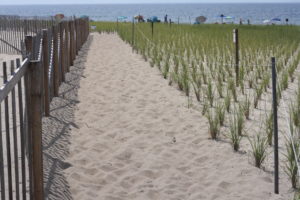TRURO — The climate crisis is “the greatest threat to the integrity of our National Park Service that we have ever experienced, and we’re at the forefront of it,” according to Cape Cod National Seashore Supt. Brian Carlstrom.
Responding to that threat includes getting creative with practicalities like dune stairways and beach bathhouses. That’s because one of the Park’s priorities is to preserve public access to the shore.
“The first site I came to here in 1986 you can no longer visit,” Carlstrom said, referring to an older configuration of Marconi Beach’s visitor access in Wellfleet.
About 35 people came to Payomet Performing Arts Center in North Truro on Aug. 14 to hear Carlstrom talk about the effects of the climate crisis on local Park Service facilities.
“We have a lot of resources in the near shore environment,” Carlstrom said. “We’ve analyzed over 200 structures and found 23 in total to be very high risk.”

Carlstrom showed slides of changing National Park lands from around the U.S., ranging from a dramatic photograph of a pronounced “bathtub ring” in the Lake Mead Recreational Area in Arizona and Nevada, where water levels have dropped over 100 feet in 20 years due to drought, to a disappearing Klondike Gold Rush glacial field in Alaska.
Here on the Outer Cape, he said, sea level rise and erosion are the most immediate challenges.
New access configurations at Herring Cove Beach in Provincetown and Nauset Light Beach in Eastham are two recent projects that model a new strategy for accommodating visitors where erosion is intense. One of the Park’s strategies, CCNS maintenance chief Karst Hoogeboom told the Independent in a phone interview, is “to reduce the amount of structure at the beach and just have the essentials there.”
Because erosion is so unpredictable, the National Seashore is now also designing beach facilities to be movable, according to Carlstrom.
“The average long-term rate of retreat at Herring Cove Beach has been 2.5 to 3 feet per year for more than a century,” said Mark Adams, a geographic information specialist and coastal geology technician with the Park Service, via email. “It’s difficult to simplify, but the Herring Cove north parking lot was subject to a rapid erosion hot spot from 2012 to 2018.” This area now seems to be protected by the growth of a barrier spit from Hatches Harbor.
Ensuring structures are easier to move starts with building them strong enough to withstand a move, according to Hoogeboom.
And if buildings are being moved, that means plumbing will be, too. Park staff are considering various plumbing choices for beach facilities.
“In some locations we’ve done vault toilets, which are a toilet building with, in effect, a big container underneath that you pump out periodically,” Hoogeboom said. The Herring Cove facilities are hooked up to the Provincetown sewer, and the Nauset facilities will have a title 5 septic system.
The bathhouse complex and concession stand at Herring Cove is a model for the entire Park complex, Carlstrom said, because they were designed to make moving them straightforward. Though given current erosion patterns, he added, “We don’t anticipate having to do so for at least a decade.”



